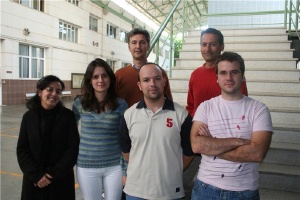Jun 5 2009
Scientists of the Electronic Technology group of the University of Seville (US), led by Professor José Manuel Quero, have completed the first phase of Mireia, a research project financed by the Plan Nacional del Ministerio de Ciencia e Innovación (National Plan of the Spanish Science and Innovation Ministry), whose aim is to develop an intelligent chip to regulate diabetes in any kind of patients suffering this disease.
 Researchers of the Hispalense University led by José Manuel Quero
Researchers of the Hispalense University led by José Manuel Quero
With this research, the idea is to extract the interstitial liquid with micro needles that are 200 microns long (the double than a hair's thickness). This painless process is carried out with sensors and micro fluidics and patients are informed every now and again in their mobiles of their level of glucose.
'There are many devices in the glucose field that do work, but the novelty of our research work is that we can use the same technology to extract liquid and to inject it', José Manuel Quero says. He does not hesitate to stress that the following stage would consist of providing insulin almost automatically, and always under medical supervision. This could be also applied to many other medicaments.
Prof. Quero points out that during the first of the four years of works, efforts have been focused on solving the different parts the patch is made up of. In the next few months issues regarding the integration of the components, assessment of the results and adjustment will be dealt with.
That is why the initial phase of the project consisted of the design of the micro needles. ‘To put it simple, we have used a biocompatible material, SU8 (photo sensible polymer) which we have processed using different techniques to obtain the needles and be able to put them in a flexible printed circuit (or PCB)' Carmen Aracil Fernández, researcher of the group points out.
In order to extract the liquid, we are using a patent of the University of Seville which allows to create a micro syringe made up by a small deposit with a whole linked to the needle which is topped by a membrane that can be destroyed in a control way.
Researchers are currently working on the creation of a system able to measure the different variables that determine factors such as the level of glucose. That's why they are focusing on the design of the Lab on Chip. ‘The idea is that the liquids we take go through a circuit designed by means of micro fluidics, where the different sensors are mixed with reactive elements, etc' , the head of the project points out.